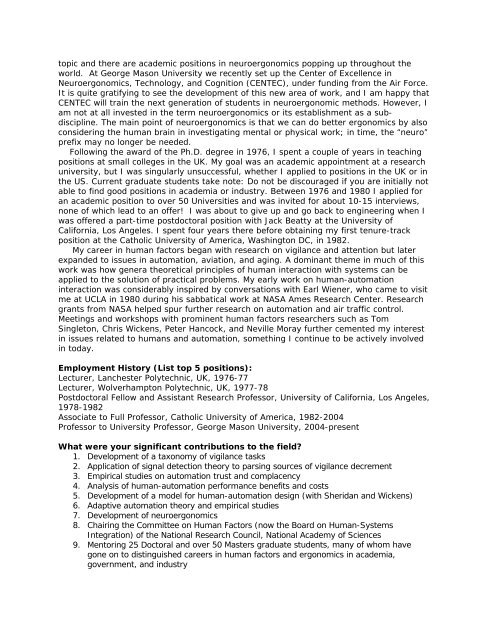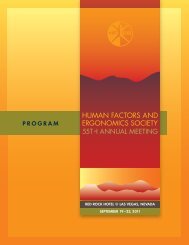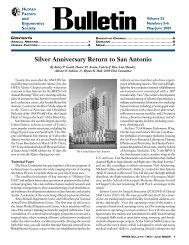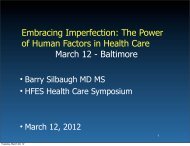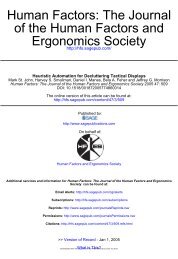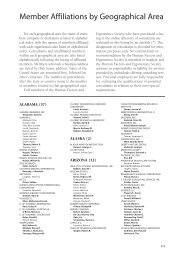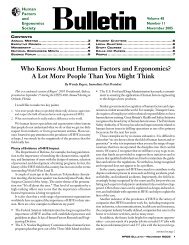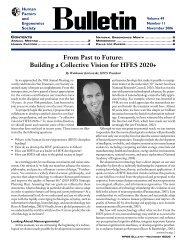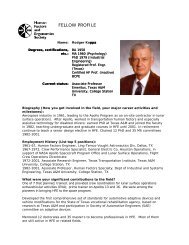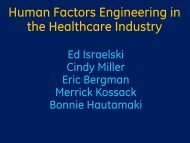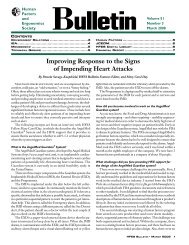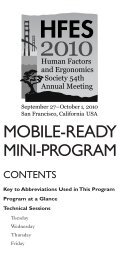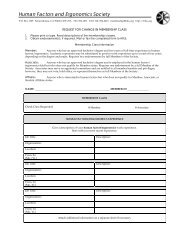Raja Parasuraman - Human Factors and Ergonomics Society
Raja Parasuraman - Human Factors and Ergonomics Society
Raja Parasuraman - Human Factors and Ergonomics Society
You also want an ePaper? Increase the reach of your titles
YUMPU automatically turns print PDFs into web optimized ePapers that Google loves.
topic <strong>and</strong> there are academic positions in neuroergonomics popping up throughout the<br />
world. At George Mason University we recently set up the Center of Excellence in<br />
Neuroergonomics, Technology, <strong>and</strong> Cognition (CENTEC), under funding from the Air Force.<br />
It is quite gratifying to see the development of this new area of work, <strong>and</strong> I am happy that<br />
CENTEC will train the next generation of students in neuroergonomic methods. However, I<br />
am not at all invested in the term neuroergonomics or its establishment as a subdiscipline.<br />
The main point of neuroergonomics is that we can do better ergonomics by also<br />
considering the human brain in investigating mental or physical work; in time, the “neuro”<br />
prefix may no longer be needed.<br />
Following the award of the Ph.D. degree in 1976, I spent a couple of years in teaching<br />
positions at small colleges in the UK. My goal was an academic appointment at a research<br />
university, but I was singularly unsuccessful, whether I applied to positions in the UK or in<br />
the US. Current graduate students take note: Do not be discouraged if you are initially not<br />
able to find good positions in academia or industry. Between 1976 <strong>and</strong> 1980 I applied for<br />
an academic position to over 50 Universities <strong>and</strong> was invited for about 10-15 interviews,<br />
none of which lead to an offer! I was about to give up <strong>and</strong> go back to engineering when I<br />
was offered a part-time postdoctoral position with Jack Beatty at the University of<br />
California, Los Angeles. I spent four years there before obtaining my first tenure-track<br />
position at the Catholic University of America, Washington DC, in 1982.<br />
My career in human factors began with research on vigilance <strong>and</strong> attention but later<br />
exp<strong>and</strong>ed to issues in automation, aviation, <strong>and</strong> aging. A dominant theme in much of this<br />
work was how genera theoretical principles of human interaction with systems can be<br />
applied to the solution of practical problems. My early work on human-automation<br />
interaction was considerably inspired by conversations with Earl Wiener, who came to visit<br />
me at UCLA in 1980 during his sabbatical work at NASA Ames Research Center. Research<br />
grants from NASA helped spur further research on automation <strong>and</strong> air traffic control.<br />
Meetings <strong>and</strong> workshops with prominent human factors researchers such as Tom<br />
Singleton, Chris Wickens, Peter Hancock, <strong>and</strong> Neville Moray further cemented my interest<br />
in issues related to humans <strong>and</strong> automation, something I continue to be actively involved<br />
in today.<br />
Employment History (List top 5 positions):<br />
Lecturer, Lanchester Polytechnic, UK, 1976-77<br />
Lecturer, Wolverhampton Polytechnic, UK, 1977-78<br />
Postdoctoral Fellow <strong>and</strong> Assistant Research Professor, University of California, Los Angeles,<br />
1978-1982<br />
Associate to Full Professor, Catholic University of America, 1982-2004<br />
Professor to University Professor, George Mason University, 2004-present<br />
What were your significant contributions to the field<br />
1. Development of a taxonomy of vigilance tasks<br />
2. Application of signal detection theory to parsing sources of vigilance decrement<br />
3. Empirical studies on automation trust <strong>and</strong> complacency<br />
4. Analysis of human-automation performance benefits <strong>and</strong> costs<br />
5. Development of a model for human-automation design (with Sheridan <strong>and</strong> Wickens)<br />
6. Adaptive automation theory <strong>and</strong> empirical studies<br />
7. Development of neuroergonomics<br />
8. Chairing the Committee on <strong>Human</strong> <strong>Factors</strong> (now the Board on <strong>Human</strong>-Systems<br />
Integration) of the National Research Council, National Academy of Sciences<br />
9. Mentoring 25 Doctoral <strong>and</strong> over 50 Masters graduate students, many of whom have<br />
gone on to distinguished careers in human factors <strong>and</strong> ergonomics in academia,<br />
government, <strong>and</strong> industry


